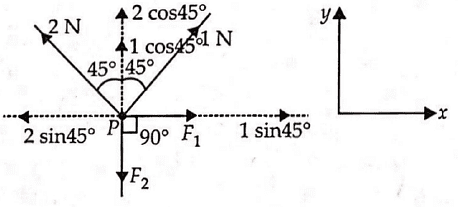NEET Exam > NEET Tests > NCERTs at Fingertips: Textbooks, Tests & Solutions > Test: Equilibrium of a Particle (NCERT) - NEET MCQ
Test: Equilibrium of a Particle (NCERT) - NEET MCQ
Test Description
5 Questions MCQ Test NCERTs at Fingertips: Textbooks, Tests & Solutions - Test: Equilibrium of a Particle (NCERT)
Test: Equilibrium of a Particle (NCERT) for NEET 2024 is part of NCERTs at Fingertips: Textbooks, Tests & Solutions preparation. The Test: Equilibrium of a Particle (NCERT) questions and answers have been
prepared according to the NEET exam syllabus.The Test: Equilibrium of a Particle (NCERT) MCQs are made for NEET 2024 Exam. Find important
definitions, questions, notes, meanings, examples, exercises, MCQs and online tests for Test: Equilibrium of a Particle (NCERT) below.
Solutions of Test: Equilibrium of a Particle (NCERT) questions in English are available as part of our NCERTs at Fingertips: Textbooks, Tests & Solutions for NEET & Test: Equilibrium of a Particle (NCERT) solutions in
Hindi for NCERTs at Fingertips: Textbooks, Tests & Solutions course. Download more important topics, notes, lectures and mock
test series for NEET Exam by signing up for free. Attempt Test: Equilibrium of a Particle (NCERT) | 5 questions in 5 minutes | Mock test for NEET preparation | Free important questions MCQ to study NCERTs at Fingertips: Textbooks, Tests & Solutions for NEET Exam | Download free PDF with solutions
Test: Equilibrium of a Particle (NCERT) - Question 1
A body subiected to three concurrent forces is found to be in equilibrium. The resultant of any two force
Detailed Solution for Test: Equilibrium of a Particle (NCERT) - Question 1
Test: Equilibrium of a Particle (NCERT) - Question 2
Three concurrent co-planar forces 1 N, 2 N and 3 N acting along different directions on a body
Detailed Solution for Test: Equilibrium of a Particle (NCERT) - Question 2
| 1 Crore+ students have signed up on EduRev. Have you? Download the App |
Test: Equilibrium of a Particle (NCERT) - Question 3
There are four forces acting at a point P produced by strings as shown in figure, which is at rest. The forces F1 and F2, are


Detailed Solution for Test: Equilibrium of a Particle (NCERT) - Question 3
Test: Equilibrium of a Particle (NCERT) - Question 4
A body of mass 10 kg is acted upon by two perpendicular forces, 6 N and 8 N. The resultant acceleration of the body is
Detailed Solution for Test: Equilibrium of a Particle (NCERT) - Question 4
Test: Equilibrium of a Particle (NCERT) - Question 5
A body is moving under the action of two forces  . Its velocity will become uniform under a third force F3 given by
. Its velocity will become uniform under a third force F3 given by
Detailed Solution for Test: Equilibrium of a Particle (NCERT) - Question 5
|
304 docs|275 tests
|
Information about Test: Equilibrium of a Particle (NCERT) Page
In this test you can find the Exam questions for Test: Equilibrium of a Particle (NCERT) solved & explained in the simplest way possible.
Besides giving Questions and answers for Test: Equilibrium of a Particle (NCERT), EduRev gives you an ample number of Online tests for practice
|
304 docs|275 tests
|
Download as PDF







 = 0
= 0










